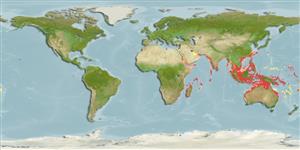Environment: milieu / climate zone / depth range / distribution range
Ecologie
marien rifbewoner; diepte 0 - 90 m (Ref. 9710). Tropical; 28°N - 35°S, 26°E - 149°W (Ref. 57373)
Indo-West Pacific: East Africa, India, and Malaysia to the Moluccas, north to Taiwan, south to northern Australia. Single record from Fiji. Appears to be absent from oceanic islands of the Indian Ocean.
Grootte / Gewicht / Leeftijd
Maturity: Lm ? range ? - ? cm
Max length : 20.0 cm TL mannelijk / geslacht onbekend; (Ref. 4113)
Korte beschrijving
Determinatiesleutels | Morfologie | Morfometrie
Dorsale stekels (totaal) : 3; Dorsale zachte stralen (totaal) : 13; Anale stekels: 0; Anale zachte stralen: 7. First dorsal spine about the same length as the 2nd dorsal spine, with a large tuff of filaments. Ground color of head and body light-tan with narrow blackish brown streaks. All fins with blackish-brown spots. Illicium longer than next dorsal fin ray with small rounded to elongate esca (Ref. 48635). Attains 45 cm SL.
Inhabits still muddy habitats that are either deep or offshore (Ref. 48635) or shallow rocky and coral reefs (Ref. 9710). Oviparous. Eggs are bound in ribbon-like sheath or mass of gelatinous mucus called 'egg raft' or 'veil' (Ref. 6773). Minimum depth reported taken from Ref. 57178. Solitary and often among leaf-eater debris (Ref 90102).
Levenscyclus en paargedrag
Maturiteit | Voortplanting | Paaien | Eieren | Fecunditeit | Larven
Oviparous. Eggs are bound in ribbon-like sheath or mass of gelatinous mucus called 'egg raft' or 'veil' (Ref. 6773).
Pietsch, T.W. and D.B. Grobecker, 1987. Frogfishes of the world. Systematics, zoogeography, and behavioral ecology. Stanford University Press, Stanford, California. 420 p. (Ref. 6773)
Status op de Rode Lijst van het IUCN (Ref. 130435: Version 2024-2)
Gevaar voor de mens
Harmless
Gebruik door de mens
Tools
Speciale rapporten
Download XML
Internetbronnen
Estimates based on models
Preferred temperature (Ref.
123201): 24.6 - 29.1, mean 28.1 °C (based on 1846 cells).
Fylogenetische diversiteitsindex (Ref.
82804): PD
50 = 0.5005 [Uniqueness, from 0.5 = low to 2.0 = high].
Bayesian length-weight: a=0.02630 (0.01029 - 0.06725), b=2.96 (2.73 - 3.19), in cm total length, based on LWR estimates for this (Sub)family-body shape (Ref.
93245).
Trofisch niveau (Ref.
69278): 4.2 ±0.73 se; based on food items.
Weerstandsvermogen (Ref.
120179): Hoog, minimale populatieverdubbelingstijd minder dan 15 maanden (Fec assumed to be > 10,000).
Fishing Vulnerability (Ref.
59153): Low vulnerability (10 of 100).
Nutrients (Ref.
124155): Calcium = 52.2 [25.3, 93.0] mg/100g; Iron = 0.623 [0.324, 1.126] mg/100g; Protein = 18.7 [16.2, 22.0] %; Omega3 = 0.122 [0.046, 0.307] g/100g; Selenium = 28.1 [12.5, 69.5] μg/100g; VitaminA = 180 [44, 716] μg/100g; Zinc = 1.03 [0.64, 1.60] mg/100g (wet weight);
